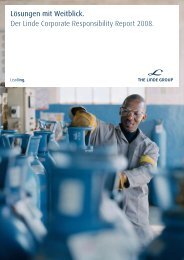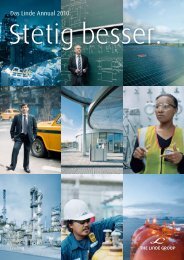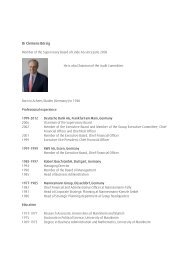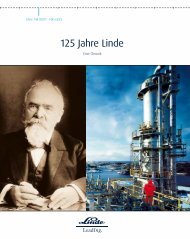The complete history of the development of The - The Linde Group
The complete history of the development of The - The Linde Group
The complete history of the development of The - The Linde Group
Create successful ePaper yourself
Turn your PDF publications into a flip-book with our unique Google optimized e-Paper software.
At first it looked as if “<strong>Linde</strong> Air” would have a market with<br />
a strong future, mainly in <strong>the</strong> chemical industry. “<strong>Linde</strong> Air” also<br />
appeared to promise sales opportunities for use as an explosive.<br />
Test blasts during <strong>the</strong> construction <strong>of</strong> <strong>the</strong> Swiss Simplon Tunnel<br />
streng<strong>the</strong>ned this hope. But this activity was ceased after <strong>the</strong><br />
First World War.<br />
Increasing demand for pure oxygen<br />
<strong>The</strong> industry’s demand for oxygen-rich gas mixtures quickly fell.<br />
<strong>The</strong> demand for pure oxygen on <strong>the</strong> o<strong>the</strong>r hand grew by leaps<br />
and bounds because autogenous (gas) welding and cutting<br />
processes began to take hold in metal working. In order not to<br />
lose his connection to this very promising market, von <strong>Linde</strong><br />
intensified his search for a new method <strong>of</strong> separating out pure<br />
oxygen.<br />
He finally convinced his son Friedrich and chemistry pr<strong>of</strong>essor<br />
Hempel to try “rectification.” This was a method <strong>of</strong> separating<br />
alcohol and water that had been long practiced in <strong>the</strong> field<br />
<strong>of</strong> chemistry: <strong>The</strong> fermented mash was heated until <strong>the</strong> alcohol<br />
evaporated. Heat was removed from <strong>the</strong> alcohol vapor by water<br />
cooling so that it could be condensed (rectification process) and<br />
captured as a liquid.<br />
Technological breakthrough<br />
Carl von <strong>Linde</strong> and his employees set in motion a comparable<br />
process, letting liquid air trickle down into to rectification column,<br />
while <strong>the</strong> oxygen vapor provided a countercurrent. This continuous<br />
process <strong>of</strong> liquefaction and evaporation produced nearly pure<br />
oxygen.<br />
At <strong>the</strong> suggestion <strong>of</strong> Pr<strong>of</strong>. Hempel, <strong>the</strong> first rectification<br />
column consisted <strong>of</strong> a steel tube filled with glass beads. This<br />
heavy apparatus with a long cool-down period was soon replaced<br />
with a lighter version with holes in <strong>the</strong> bottom instead <strong>of</strong> glass<br />
beads. Von <strong>Linde</strong> and his employees combined <strong>the</strong> liquefaction<br />
1908 1909<br />
Hans Köppen <strong>of</strong> Germany wins <strong>the</strong> international “Around <strong>the</strong><br />
World” auto race from New York to Paris in 165 days.<br />
<strong>The</strong> <strong>Linde</strong> plant facilities in Höllriegelskreuth in 1909 (top)<br />
and 1929 (bottom).<br />
and separation units into one unit. “This opened up <strong>the</strong> road<br />
by which low-temperature technology finally found success in<br />
industry,” wrote von <strong>Linde</strong> on this sensational breakthrough.<br />
One <strong>of</strong> <strong>the</strong> first production plants, which was used to generate<br />
gas for many years, went into operation in Höllriegelskreuth,<br />
near Munich, in 1903.<br />
Nitrogen production<br />
<strong>The</strong> publication <strong>of</strong> this new process in 1902 not only attracted a<br />
number <strong>of</strong> imitators to <strong>the</strong> scene, but also aroused <strong>the</strong> interest<br />
<strong>of</strong> <strong>the</strong> chemical industry in pure nitrogen. Nitrogen compounds<br />
(calcium cyanamide, ammonia) were gaining increasing importance<br />
as fertilizers.<br />
In a modified rectification process, <strong>the</strong> team in Höllriegelskreuth<br />
achieved nitrogen purification as well in 1903. <strong>Linde</strong> sold <strong>the</strong><br />
first such plant to an Italian customer in 1905. And by 1910 <strong>the</strong><br />
team, under <strong>the</strong> direction <strong>of</strong> Friedrich <strong>Linde</strong> and Rudolf Wucherer,<br />
had developed a “two-column apparatus,” which delivered pure<br />
oxygen and pure nitrogen at <strong>the</strong> same time at a low cost.<br />
German chemist Fritz H<strong>of</strong>mann successfully<br />
produces syn<strong>the</strong>tic rubber.<br />
29


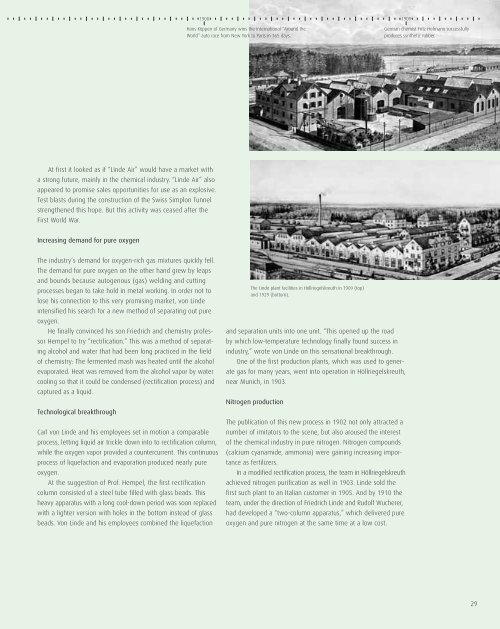
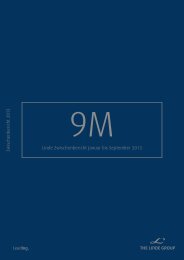
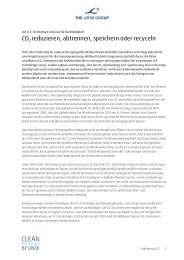

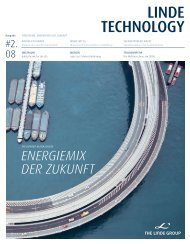

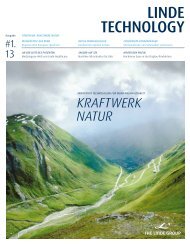

![[41] Anteilsbesitzliste des Linde Konzerns und ... - The Linde Group](https://img.yumpu.com/8356102/1/184x260/41-anteilsbesitzliste-des-linde-konzerns-und-the-linde-group.jpg?quality=85)
![[41] Anteilsbesitzliste des Linde Konzerns und ... - The Linde Group](https://img.yumpu.com/8356076/1/184x260/41-anteilsbesitzliste-des-linde-konzerns-und-the-linde-group.jpg?quality=85)
